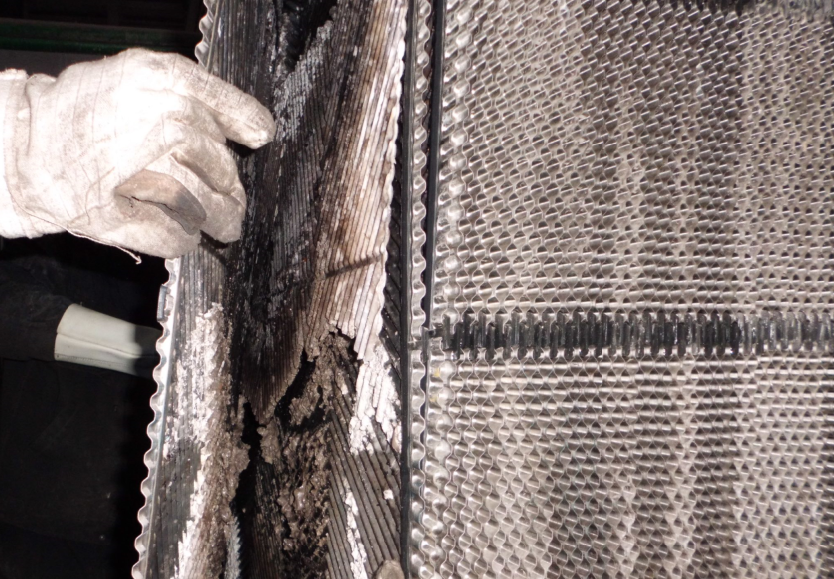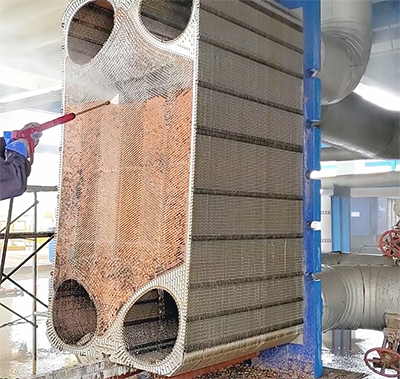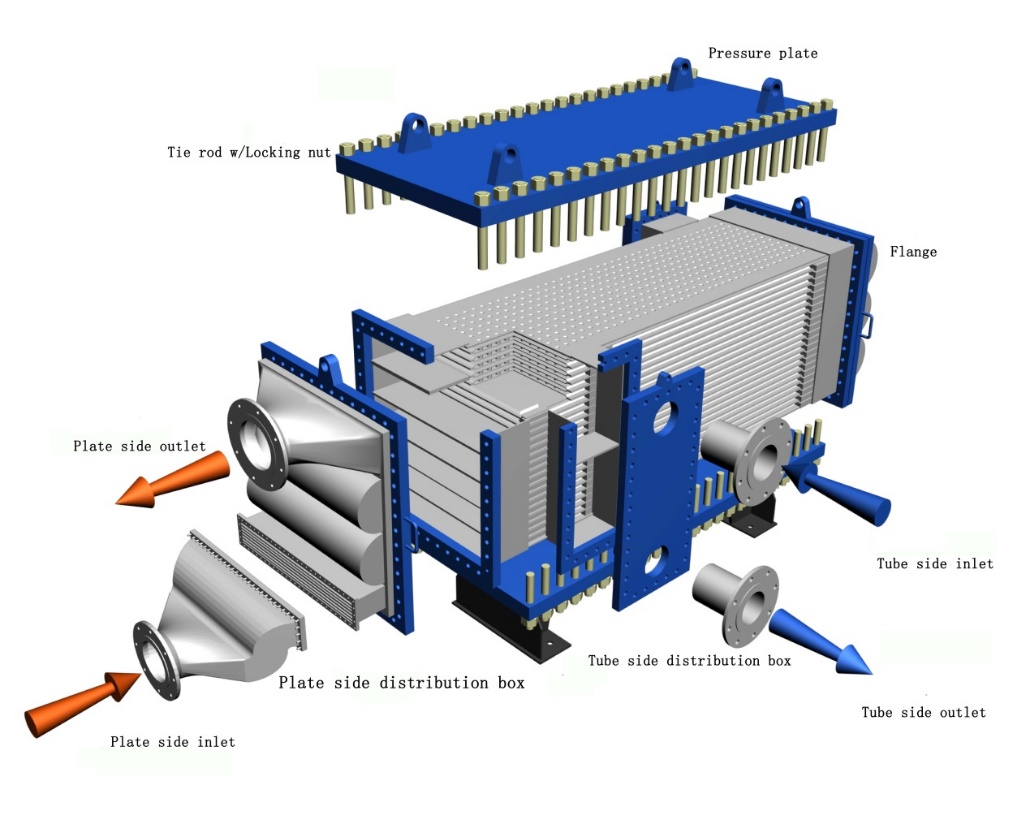How to Check if Your Plate Heat Exchanger is Blocked?
Plate heat exchangers (PHEs) are vital components across numerous industries, from HVAC and chemical processing to food and beverage production. Their compact design and high thermal efficiency make them indispensable for transferring heat effectively. However, the very narrow channels that contribute to their efficiency also make them susceptible to internal blockages, often referred to as fouling or scaling.
Blocked PHEs can significantly reduce performance, increase energy consumption, and lead to costly downtime or even equipment failure. Early detection is crucial for maintaining system integrity and optimizing operational costs. But how can you definitively tell if your welded or gasketed plate heat exchanger is blocked?
Blocked Plate Heat Exchanger Troubleshooting
Common causes of blockages include:
● Stressed plates or gaskets:
Stressed or damaged gaskets are one of the most common causes of why a gasketed plate exchanger becomes blocked. If the gaskets that seal the plates in a heat exchanger break or wear out, fluids can mix together and cause a blockage. Installing new gaskets will fix this issue.
● Scaling:
Precipitation of dissolved salts and minerals from hard water or fluids with high mineral content, forming hard deposits.
● Corrosion By-Products:
Oxides and sludge released from corroding metal components within the system.
● Biofouling:
Growth of microbial films and organisms, particularly in systems with organic content or stagnant flow.
● Chemical Reaction Fouling:
Deposits formed by chemical reactions occurring within the fluid or on the plate surface.
● Particulate Buildup:
Suspended solids like sediment, rust, or debris in the process fluid getting trapped in the narrow plate gaps.

Key Indicators of a Blocked Plate Heat Exchanger
Recognizing the symptoms is the first step in identifying a blockage. Monitor these key indicators:
1. Increased Pressure Drop:
This is often the earliest and most accurate sign. As fouling restricts the flow area, frictional resistance increases, requiring more pumping power and resulting in a higher-pressure difference between the inlet and outlet connections. Monitor pressure gauges upstream and downstream.
2. Reduced Thermal Performance:
If the heat exchanger isn't achieving the desired temperature change between the hot and cold streams, or if outlet temperatures deviate from expected values, it indicates impaired heat transfer due to the insulating effect of fouling.
3. Decreased Flow Rates:
Blocked passages physically obstruct fluid flow, leading to a reduction in the actual flow rate compared to the system's design specifications, even with consistent pump operation.
4. Unusual Noises:
Gurgling, hissing, or knocking sounds can sometimes indicate turbulent flow patterns caused by partial blockages or cavitation in constricted areas.
5. External Leakage:
While less common as a primary indicator of blockage (more often related to gasket or plate issues), sudden leakage concurrent with other blockage symptoms should be investigated as a potential related problem caused by increased internal pressure.
How to Diagnosis a blocked PHE Step-by-Step?
To accurately detect and safely address blockages, follow these steps:
1. Collect Historical Operating Data: Compare current performance metrics with baseline values and historical trends.
2. Check Sensor Calibration: Ensure all pressure gauges, temperature sensors, and flow meters are properly calibrated and functioning.
3. Monitor Pressure and Temperature: Continuously record inlet/outlet pressures and temperatures, looking for anomalies.
4. Isolate and Cool Down: Safely shut down the system, relieve pressure, and allow the unit to cool before any physical inspection.
5. Disassemble for Inspection (if applicable): If it's a gasketed unit, open it and visually inspect the plates for fouling or damage.
6. Conduct Non-Destructive Tests: Utilize techniques like thermography or ultrasonic testing if internal disassembly isn't possible or practical.
7. Document Findings: Keep detailed records of the type and severity of fouling, affected areas, and any other observations to inform future maintenance and prevention strategies.
Prevent a Blocked Plate Heat Exchanger
Preventing blockages is significantly more cost-effective than dealing with their consequences. Implement these proactive measures:
● Install Pre-Filtration Systems:
Use filters or strainers upstream of the heat exchanger to remove particulate matter before it enters the plate pack.
● Implement Cleaning-in-Place (CIP):
Periodically circulate cleaning chemicals through the unit without disassembly to remove deposits.
● Use Treated Fluids:
Employ water softening or chemical conditioning to reduce the risk of scaling, especially with hard water.
● Maintain Appropriate Fluid Velocity:
Ensure sufficient flow velocity within the channels to create turbulence, which helps inhibit deposition.
● Routine Visual Inspections:
Schedule regular inspections (especially during planned maintenance) to catch early signs of fouling.
● Consistent KPI Monitoring:
Use automated logging of temperature, pressure, and flow to enable real-time monitoring and alerts for deviations.
How to Deal with a Blocked Plate Heat Exchanger?
Cleaning a Blocked Plate Heat Exchanger
Regular cleaning is essential to remove debris, scaling, and build-up that accumulate over time. There are two common cleaning methods:
Chemical cleaning: This method uses chemical cleaning agents circulated through the exchanger without disassembling it. It’s ideal for mild to moderate fouling and helps maintain consistent performance.
Manual Cleaning: For more severe blockages, disassembling the exchanger may be necessary. Plates are removed and cleaned individually using soft brushes or pressure washing, depending on the type of fouling.
Routine cleaning not only restores heat transfer efficiency but also extends the life of the equipment.
For More Details About Cleaning Methods, Please Check → Step-by-Step Cleaning Process for Plate Heat Exchangers

Replace Faulty Gaskets
Gaskets play a key role in sealing the plates and keeping the fluids separate. Over time, they can wear out, crack, or lose elasticity. When this happens, fluids may leak or mix, potentially leading to blockages or even damage to the plates.
If you notice leaks or reduced performance, inspect the gaskets closely. Replacing faulty gaskets with new ones is a straightforward way to resolve the issue and restore the exchanger to proper working condition.
Choosing the Right Plate Heat Exchanger
The design of different types of heat exchanger itself can influence its susceptibility to fouling and the ease of addressing blockages. Consider the fluid characteristics and potential for fouling when selecting a unit:
● Gasketed Plate Heat Exchangers:
Easily opened for visual inspection and mechanical cleaning, suitable for applications requiring regular maintenance access.
● Welded Plate Heat Exchangers (including HT-Bloc and TP):
Robust and leak-free for high pressures/temperatures, but less accessible for physical cleaning. Rely more on performance monitoring and chemical cleaning/jetting through ports.
● Printed Circuit Heat Exchangers (PCHE):
Highly compact and efficient for extreme conditions, but with very fine passages that are difficult to clean physically. Prevention through meticulous fluid quality control is paramount; detection relies almost entirely on performance monitoring.
● Wide-Gap Welded Plate Heat Exchangers:
Designed with wide gap free flow channels to handle fouling fluids with higher suspended solids or viscosity, reducing the risk of particulate fouling and improving self-cleaning and CIP effectiveness.

In summary
Choosing the right type of heat exchanger for your specific application further contributes to long-term reliability and optimal performance. A strategic approach to monitoring and maintenance is essential for ensuring the efficient and uninterrupted operation of your plate heat exchangers.
Shanghai Heat Transfer Equipment Co., Ltd. specializes in the design, manufacturing, installation, and service of plate heat exchangers and complete heat transfer systems.
If you need further consultation and discussion, please feel free to contact us.
Email: info@shphe.com
WhatsApp / Cell: +86 15201818405




